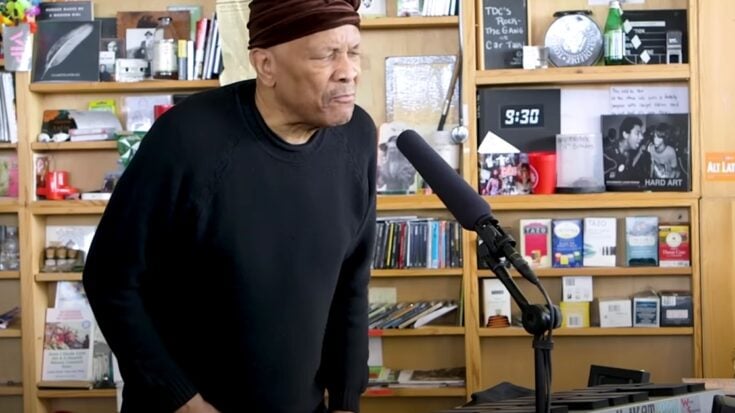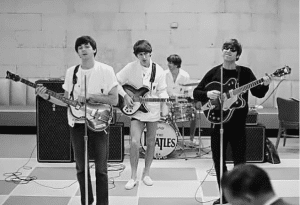Famous Musicians Many Fans Didn’t Know Died Already

via NPR Music / YouTube
The music world never really stops moving. New stars rise, scandals dominate feeds, and viral moments grab the spotlight for a few days before the next wave comes along. In that constant churn, even news that once would have been front-page material can slip past unnoticed. For many musicians whose fame peaked decades ago, their passing often receives less attention than the impact they had when their songs were everywhere.
It’s a strange contrast. These are artists who once filled arenas, sold millions of records, or defined the sound of an era, yet when the end came, their names barely registered in the broader conversation. With so much happening online and in entertainment media every hour, a quiet announcement of their death can easily be drowned out, overlooked by audiences who simply never heard about it.
That doesn’t make their loss any less significant. These were voices and talents that shaped music history, and their absence deserves recognition. This article looks back at musicians who left us without the spotlight they once commanded—figures whose deaths may have escaped many fans’ notice, but whose influence is still worth remembering.
Sam Moore
Sam Moore’s voice defined an era of rhythm and blues. As one half of Sam and Dave, his powerful delivery helped turn songs like “Soul Man,” “Hold On, I’m Coming,” and “I Thank You” into anthems of the 1960s. Those hits not only earned their place in music history but also helped secure Sam and Dave’s induction into the Rock and Roll Hall of Fame in 1992. Even after his solo career struggled and personal battles with addiction became public, Moore’s influence continued to echo through covers, performances, and cultural references.
The duo’s resurgence in the late 1970s and early 1980s through The Blues Brothers sketches and film gave Moore a second wave of recognition. His songs reached a whole new audience, ensuring that his work never truly disappeared from the spotlight. For many, the joy and soul embedded in his performances symbolized the golden age of Stax Records and Memphis soul.
On January 10, 2025, complications following surgery ended Moore’s life in Coral Gables, Florida. He was 89. His passing marked the end of a remarkable journey, yet it slipped by with less fanfare than the music he once brought to millions. Moore’s story is a reminder of how even the most vital voices of a generation can fade quietly, despite the timelessness of their songs.
Roberta Flack
Roberta Flack’s artistry was both gentle and powerful, weaving together pop, soul, and sophistication in a way few others could match. Her recording of “The First Time Ever I Saw Your Face” in 1972 became Billboard’s song of the year, and the following year, she delivered another global hit with “Killing Me Softly with His Song.” Both tracks earned her back-to-back Grammys for Record of the Year, a rare achievement that solidified her as one of the most distinctive voices of the 1970s.
Flack’s music carried a calm intensity that resonated with listeners who wanted something more contemplative than the disco beats or arena rock of her era. Through the 1980s, she remained a steady presence on adult contemporary and R&B charts, performing with unmatched grace and emotional depth. Her influence extended far beyond her chart success, as countless artists have drawn from her intimate style of storytelling.
In 2022, Flack revealed that ALS had forced her to step away from performing. On February 24, 2025, she passed away at her home in New York at the age of 88. Despite her towering legacy, her death didn’t capture the headlines it might have decades earlier, but her music continues to live on as part of the soundtrack of modern pop and soul.
Marianne Faithfull
Marianne Faithfull became a central figure in London’s swinging ’60s, tied closely to the Rolling Stones both personally and musically. Her delicate cover of “As Tears Go By” made her a star in 1964, and she went on to record memorable versions of “Come and Stay with Me” and “Yesterday.” Beyond her music, she embodied the mystique and turbulence of the counterculture era, often blurring the lines between her personal life and her art.
After years out of the spotlight, Faithfull staged a remarkable comeback in 1979 with Broken English. The record’s fusion of rock and electronic textures reintroduced her as a daring, evolved artist, and it became one of the defining albums of her career. She later lent her distinctive, weathered voice to Metallica’s “The Memory Remains,” bridging generations of rock in an unexpected way.
On January 30, 2025, Faithfull died in London at age 78, surrounded by family. While she had long struggled with health issues ranging from emphysema to cancer, the official cause was never shared. Her passing was quieter than her life, but her work as a singer, actress, and survivor of rock’s wildest years ensures her legacy endures.
Rick Derringer
Rick Derringer lived a life steeped in rock history. At just 17, he and his band The McCoys shot to the top of the U.S. charts with “Hang On Sloopy,” a garage rock anthem that defined 1965. By the following decade, Derringer reinvented himself as guitarist and producer for the Edgar Winter Group, contributing to staples like “Frankenstein” and “Free Ride.” Alongside that, his solo hit “Rock and Roll, Hoochie Koo” became a staple of classic rock radio.
Derringer’s career stretched across decades and genres. By the 1980s, he was working with an eclectic roster of artists ranging from Steely Dan and Meat Loaf to Cyndi Lauper and “Weird Al” Yankovic. He also left a mark on pop culture through wrestling, writing entrance themes like Hulk Hogan’s “Real American,” a song that still resonates in sports and entertainment.
After years of declining health, Derringer passed away in Ormond Beach, Florida, on May 26, 2025. He was 77. For a man who seemed always ready to adapt to the changing tides of music, his passing was surprisingly quiet in the press. Yet the echoes of his riffs and his enduring contributions remain woven into American rock history.
David Johansen
David Johansen wanted rock music to feel dangerous again, and with the New York Dolls, he accomplished exactly that. In the early 1970s, the band’s flamboyant style, gritty sound, and raw energy made them cult favorites and laid groundwork for punk rock. Johansen’s gravelly voice and magnetic stage presence turned him into an underground icon, even if mainstream success proved elusive.
Never one to be boxed in, Johansen reinvented himself a decade later as Buster Poindexter, a campy lounge persona who delivered the party hit “Hot Hot Hot.” It was a surprising twist for fans who knew him from the Dolls, but it showcased his versatility and ability to move between music and performance art. He embodied the kind of restless creativity that kept audiences guessing.
Behind the scenes, Johansen faced a long health battle with cancer. After a serious fall in late 2024 left him bedridden, his condition worsened. In April 2025, he died at his home in New York City at the age of 75. While his death didn’t dominate headlines, Johansen’s legacy as both a punk pioneer and a fearless entertainer remains undeniable.
Clem Burke
Clem Burke’s drumming was the heartbeat of Blondie, one of the most stylistically adventurous bands to emerge from New York’s punk scene. As the group shifted between punk, disco, reggae, New Wave, and even early rap, Burke adapted seamlessly, delivering the energy and precision needed to keep up with Debbie Harry and the rest of the band. His versatility helped Blondie become one of the few punk-rooted acts to achieve massive mainstream success, earning a spot in the Rock and Roll Hall of Fame.
When Blondie took a long break in the late 1980s, Burke found himself behind the kit for the Ramones, briefly performing as “Elvis Ramone.” It was a short-lived stint, but it showed how highly regarded he was among his peers in the punk community. Beyond Blondie, his work across projects and collaborations solidified his reputation as one of rock’s most dependable and dynamic drummers.
On April 6, 2025, Burke died of cancer at the age of 70. The announcement, made by Blondie the following day, marked a significant loss for the music world. While his passing didn’t dominate headlines, his impact is undeniable — he was the steady force behind some of the most enduring songs of the late 20th century.
Wayne Osmond
The Osmonds were synonymous with wholesome entertainment in the 1970s, and Wayne Osmond was central to the family’s success. While siblings Donny and Marie often took the spotlight, Wayne’s musicianship grounded the group. He was a multi-instrumentalist, vocalist, and performer who contributed to their No. 1 hit “One Bad Apple” and helped carry the family’s polished sound through a decade of TV shows, tours, and recordings.
Behind the scenes, however, Wayne faced immense personal challenges. In 1994, he was diagnosed with a brain tumor after collapsing on stage, and the resulting treatments left him unable to play certain instruments and robbed him of much of his hearing. A stroke in 2012 further limited his ability to perform. Despite these setbacks, Wayne remained a beloved member of the Osmond family and its legacy.
On January 1, 2025, Wayne Osmond suffered another stroke that proved fatal. He was 73 years old. While his health struggles overshadowed much of his later life, his contributions to one of the biggest pop families in history remain a vital part of the Osmonds’ story.
Alf Clausen
For nearly three decades, Alf Clausen was one of television’s most important composers, best known for shaping the musical identity of The Simpsons. From 1990 to 2017, he crafted elaborate scores and humorous original songs that became as much a part of the show’s DNA as its characters. His work earned him 23 Emmy nominations and two wins, including for standout numbers like “We Put the Spring in Springfield.”
Clausen’s career extended far beyond Springfield. He scored films such as Splash and The Beastmaster and contributed music to TV shows like Moonlighting, Fame, and The Critic. His versatility made him one of the most respected names in television composition. His departure from The Simpsons in 2017, reportedly over budget cuts, was a controversial end to a long and influential run.
In the early morning of May 29, 2025, Clausen passed away at the age of 84 after a decade-long battle with progressive supranuclear palsy. While his name might not be familiar to casual viewers, his work defined the sound of an entire era of television comedy and continues to influence TV composers today.
https://twitter.com/fourfingerpod/status/1928616154471309784
Nino Tempo
Nino Tempo’s career spanned almost the entirety of modern popular music. As a child prodigy, he sang with Benny Goodman’s band in the 1940s, and later he became a sought-after saxophonist, recording with stars like Frank Sinatra and Bobby Darin. His adaptability carried him through changing eras of music, from big band and pop to funk and jazz, where he always seemed to find his footing.
Tempo’s biggest commercial success came in 1963, when he and his sister April Stevens recorded “Deep Purple.” Their tender rendition of the standard topped the Billboard Hot 100 and won a Grammy Award, cementing their place in pop history. It was a career highlight that ensured Tempo’s name would always be linked with a classic of mid-century American music.
On April 10, 2025, Tempo died at his home in West Hollywood at the age of 90. The announcement was made by a close friend a week later. His passing didn’t make a major splash in entertainment headlines, but his contributions across decades of music remind us of the breadth of talent that helped shape American popular culture.
Robert John
Robert John’s career stretched far beyond his reputation as a supposed one-hit wonder. Beginning as Bobby Pedrick Jr. in the late 1950s, he released records as a child before joining Bobby and the Consoles. Reinventing himself as Robert John, he found success in the 1970s with smooth, heartfelt pop singles. His version of “The Lion Sleeps Tonight” reached No. 3 in 1972, but it was his 1979 ballad “Sad Eyes” that became his signature, topping the Billboard Hot 100 and cementing his place in soft rock history.
Though best known for that single, John was also an accomplished studio musician and songwriter, contributing behind the scenes as much as in front of the microphone. His gentle style captured the mood of late ’70s pop, a period that embraced romantic, melodic sounds amid the harder edges of disco and rock. For fans of the era, his work represents a softer side of popular music.
On February 24, 2025, Robert John died at the age of 79. His son confirmed the news but did not reveal the cause, noting that John had been recovering from a stroke. While his passing may not have made major headlines, his music remains part of the soundtrack of an era defined by emotional, radio-friendly ballads.
Jerry Butler
Jerry Butler was the original star of the Impressions before Curtis Mayfield rose to prominence. With his rich and commanding voice, Butler led the group through early classics like “For Your Precious Love” and “Gypsy Woman.” Nicknamed “The Ice Man,” he later embarked on a solo career that produced a steady stream of hits, including “He Will Break Your Heart” and “I Stand Accused.” Through the 1960s and 1970s, Butler was a familiar voice on R&B radio.
His influence extended beyond music. Butler became a respected figure in the Civil Rights Movement, using his platform to promote justice and equality. Later, he transitioned into politics, serving as a Chicago alderman for more than three decades. Few artists managed to balance careers in both music and public service as effectively as Butler, making him a rare and enduring presence in American culture.
On February 20, 2025, Butler passed away at the age of 85 after battling Parkinson’s disease. His death marked the loss of not only a legendary R&B singer but also a civic leader who shaped both sound and society. Though his passing was quieter than his influence deserved, Butler’s legacy remains deeply felt.
Roy Ayers
Roy Ayers was a pioneer who blurred the boundaries between jazz, funk, soul, and R&B. Inspired by a gift of mallets from vibraphonist Lionel Hampton when he was just a child, Ayers devoted his life to music. In the 1970s, he founded Roy Ayers Ubiquity, a collective that combined jazz improvisation with groove-driven funk and dance music, creating a sophisticated yet accessible sound that inspired generations of musicians.
His 1976 track “Everybody Loves the Sunshine” became a cultural landmark, capturing a laid-back vibe that resonated across decades. Ayers’ catalog was sampled heavily by hip-hop artists in the 1990s and 2000s, cementing his place as a bridge between genres and eras. From A Tribe Called Quest to Mary J. Blige, countless musicians carried his influence into new contexts, proving his music’s timeless appeal.
On March 4, 2025, Ayers died in New York City at the age of 84 after a long illness. His family announced the news on social media, celebrating his vibrant life and legacy. While his death may not have commanded wall-to-wall coverage, Ayers’ work continues to echo wherever jazz, funk, and soul intersect.
Mick Ralphs
Mick Ralphs was central to the sound of two beloved ’70s rock bands: Mott the Hoople and Bad Company. With Mott the Hoople, he co-wrote tracks like “All the Young Dudes” and “Honaloochie Boogie,” contributing to the glam rock scene that shaped early 1970s Britain. His departure to help form Bad Company brought him into one of the era’s most successful supergroups, alongside members of Free and King Crimson.
As a guitarist and songwriter, Ralphs created enduring riffs that became staples of arena rock. Songs like “Can’t Get Enough,” “Feel Like Making Love,” and “Bad Company” remain classic rock radio mainstays. His playing combined accessibility with power, striking a balance that defined Bad Company’s appeal.
In June 2025, Ralphs died at the age of 81, years after suffering a debilitating stroke in 2016 that left him largely incapacitated. His final years were quiet, but his music continues to roar through concert speakers and playlists, a reminder of his crucial role in shaping the sound of ’70s rock.
Bobby Sherman
Bobby Sherman was one of the brightest teen idols of the late 1960s and early 1970s, adored by fans for his clean-cut charm and catchy pop singles. Songs like “Little Woman,” “Julie, Do Ya Love Me,” and “Easy Come, Easy Go” dominated the charts during his peak, and his roles on TV series such as Here Come the Brides added to his appeal. Between 1969 and 1971, Sherman had seven top-40 singles, making him a household name.
Unlike many of his peers, Sherman transitioned into an entirely different life once the teen idol spotlight faded. He became a paramedic, a CPR instructor for the Los Angeles Police Department, and later a reserve deputy sheriff. His second career earned him respect for dedicating himself to public service, a rare and admirable path for a former pop star.
On June 24, 2025, Sherman’s wife announced his death through family friend John Stamos. At 81, he passed away after a battle with Stage 4 cancer. Remembered fondly by fans of his music and admired for his later work in saving lives, Sherman’s story is one of reinvention, resilience, and quiet grace.
https://twitter.com/ThatEricAlper/status/1937568085575135521











